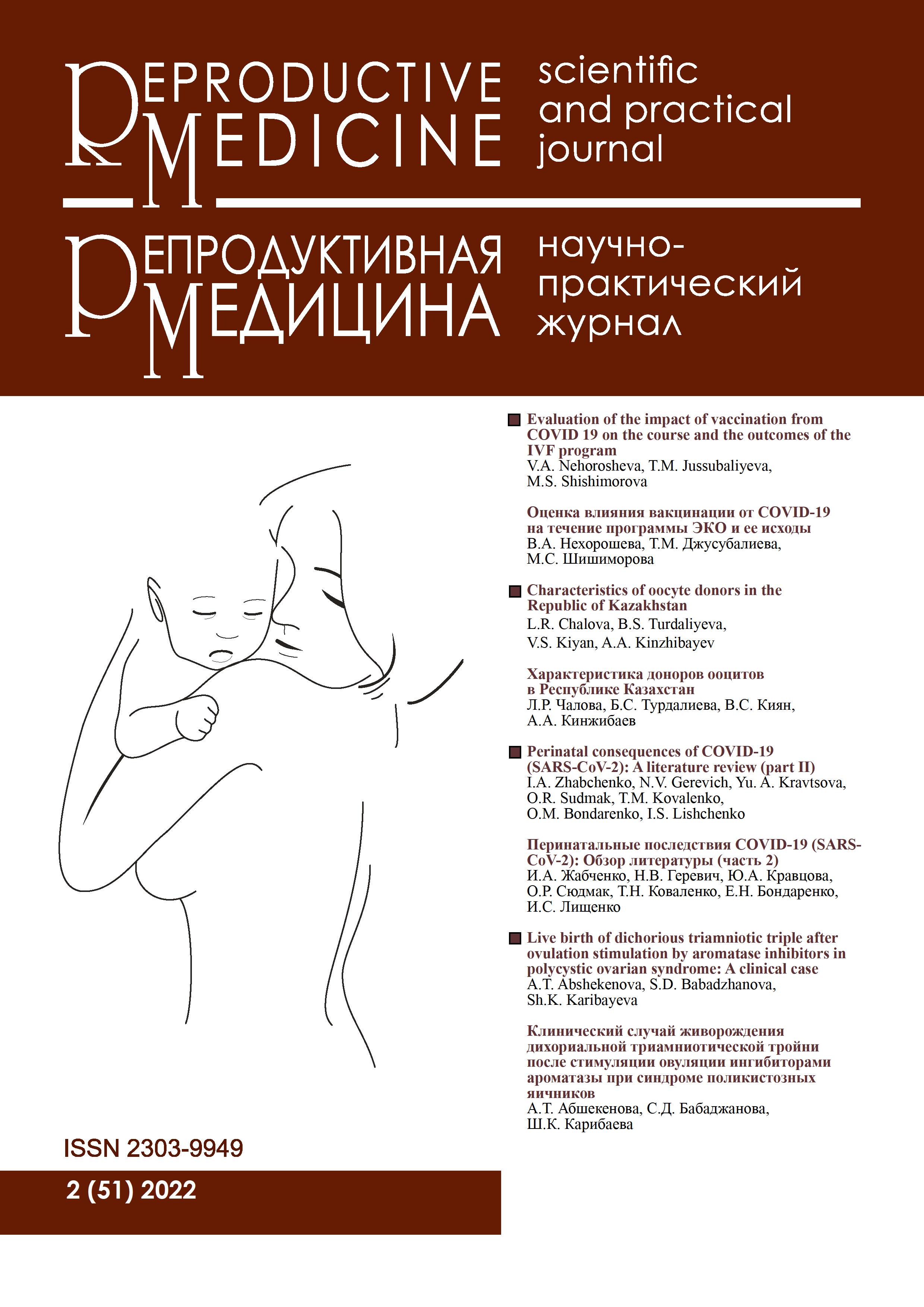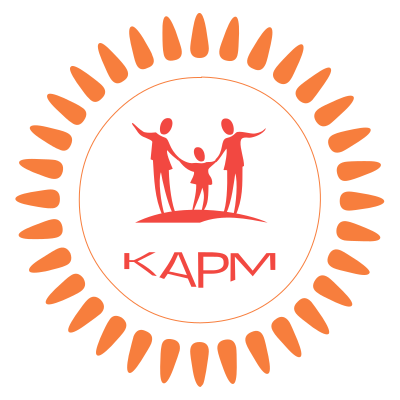Characteristics of oocyte donors in the Republic of Kazakhstan
DOI:
https://doi.org/10.37800/RM.2.2022.14-21Keywords:
ART, oocyte donation, motives for donation, anonymity, donor record-keeping, IVFAbstract
Relevance: The World Health Organization reported about 48.5 million infertile couples worldwide in 2013. 19.2 million of them faced difficulties in having their first child. Nowadays, women postpone marriage and childbirth to a later date. For various reasons, this leads to problems conceiving, including the absence of their eggs. The development of reproductive
medicine made it possible to use donor gametes for treating infertility due to the lack of own genetic material. As a result, the use of gamete donors is encouraged, which becomes a significant link of in vitro fertilization programs.
The study aimed to obtain a socio-medical profile of oocyte donors in the Republic of Kazakhstan in 2020-2021.
Methods: The study analyzed the reproductive history of oocyte donors, their attitude to the donation procedure, the issues of keeping records of the use of their genetic material, and maintaining anonymity.
Results: In this study, 82.86% of donors were aged 26 to 35; 58.8% of them were ethnic Kazakhs; 80% were motivated by the financial compensation. At that, 53.13% of donors were dissatisfied with the amount paid for their participation in the donation program. 79.41% would agree to donate again, and 58.8% have already donated several times. While a third of the respondents were concerned about their health, the other third had no special feelings before donation. 52.94% of donors considered a
possibility that children born using their oocytes could meet in the future. Approximately 60% of respondents believed their anonymity at donation is preserved and would not like their information stored in a unified gamete donor register for fear of violating their privacy.
Conclusion: The study results indicate that financial compensation was the principal motivation for 80.0% of oocyte donors in the Republic of Kazakhstan. Concerns of oocyte donors for their health are inevitable since the procedure of stimulation and retrieval of oocytes is associated with certain risks, both anesthetic and surgical. Despite this, more than half of the respondents agree to be donors repeatedly for various reasons. More than half of the donors see their donation as anonymous and would not like to have any record in the electronic database of the registered gamete donors.
References
Chalova LR, Lokshin VN. Mitochondrial replacement therapy: future or present? Reproductive Medicine. 2020; 2(43):7-12. http://doi.org/10.37800/rm2020-1-9.
Об утверждении правил и условий проведения донорства половых клеток, тканей репродуктивных органов. Приказ Министра здравоохранения Республики Казахстан от 8 декабря 2020 года № ҚР ДСМ-236/2020. Зарегистрирован в Министерстве юстиции Республики Казахстан 11 декабря 2020 года №21760. Доступно по: https://adilet.zan.kz/rus/docs/V2000021760. [Ob utverzhdenii pravil i uslovij provedenija donorstva polovyh kletok, tkanej reproduktivnyh organov. Prikaz Ministra zdravoohranenija Respubliki Kazahstan ot 8 dekabrja 2020 goda № ҚR DSM-236/2020. Zaregistrirovan v Ministerstve justicii Respubliki Kazahstan 11 dekabrja 2020 goda № 21760 (In Russ.).]
О здоровье народа и системе здравоохранения. Кодекс Республики Казахстан от 7 июля 2020 года №360-VI ЗРК. Доступно по: https://adilet.zan.kz/rus/docs/K2000000360/k20_360.htm. [O zdorov'e naroda i sisteme zdravoohranenija. Kodeks Respubliki Kazahstan ot 7 ijulja 2020 goda № 360-VI ZRK (In Russ.).]
О браке (супружестве) и семье. Кодекс Республики Казахстан от 26 декабря 2011 года № 518-IV. Доступно по: https://adilet.zan.kz/rus/docs/K1100000518. [O brake (supruzhestve) i sem'e. Kodeks Respubliki Kazahstan ot 26 dekabrja 2011 goda № 518-IV (in Russ.).]
De Geyter C, Calhaz-Jorge C, Kupka MS, Wyns C, Mocanu E, Motrenko T, Scaravelli G, Smeenk J, Vidakovic S, Goossens V; European IVF-monitoring Consortium (EIM) for the European Society of Human Reproduction and Embryology (ESHRE). ART in Europe, 2014: results generated from European registries by ESHRE. Hum Reprod. 2018 Sep 1; 33(9):1586-1601. https://doi.org/10.1093/humrep/dey242
De Geyter C, Calhaz-Jorge C, Kupka MS, Wyns C, Mocanu E, Motrenko T, Scaravelli G, Smeenk J, Vidakovic S, Goossens V; European IVF-monitoring Consortium (EIM) for the European Society of Human Reproduction and Embryology (ESHRE). ART in Europe, 2015: results generated from European registries by ESHRE. Hum Reprod Open. 2020 Feb 24; 2020(1):hoz038. https://doi.org/10.1093/hropen/hoz038. Erratum in: Hum Reprod Open. 2020 Sep 22; 2020(3):hoaa038.
Wyns C, Bergh C, Calhaz-Jorge C, De Geyter C, Kupka MS, Motrenko T, Rugescu I, Smeenk J, Tandler-Schneider A, Vidakovic S, Goossens V. European IVF-monitoring Consortium (EIM) for the European Society of Human Reproduction and Embryology (ESHRE). ART in Europe, 2016: results generated from European registries by ESHRE. Hum Reprod Open. 2020 Jul 31; 2020(3):hoaa032. https://doi.org/10.1093/hropen/hoaa032
Wyns C, De Geyter C, Calhaz-Jorge C, Kupka MS, Motrenko T, Smeenk J, Bergh C, Tandler-Schneider A, Rugescu IA, Vidakovic S, Goossens V. European IVF-Monitoring Consortium (EIM) for the European Society of Human Reproduction and Embryology (ESHRE). ART in Europe, 2017: results generated from European registries by ESHRE. Hum Reprod Open. 2021 Aug 5; 2021(3):hoab026. https://doi.org/10.1093/hropen/hoab026
Cobo A, Remohí J, Chang CC, Nagy ZP. Oocyte cryopreservation for donor egg banking. Reprod Biomed Online. 2011 Sep;23(3):341-6. https://doi.org/10.1016/j.rbmo.2011.05.014
Khalili MA, Shahedi A, Ashourzadeh S, Nottola SA, Macchiarelli G, Palmerini MG. Vitrification of human immature oocytes before and after in vitro maturation: a review. J Assist Reprod Genet. 2017 Nov; 34(11):1413-1426. https://doi.org/10.1007/s10815-017-1005-4
Sauer MV, Kavic SM. Oocyte and embryo donation 2006: reviewing two decades of innovation and controversy. Reprod Biomed Online. 2006 Feb; 12(2):153-62. https://doi.org/10.1016/s1472-6483(10)60855-3
Liang T, Motan T. Mature Oocyte Cryopreservation for Fertility Preservation. Adv Exp Med Biol. 2016; 951:155-161. https://doi.org/10.1007/978-3-319-45457-3_13
Söderström-Anttila V, Miettinen A, Rotkirch A, Nuojua-Huttunen S, Poranen AK, Sälevaara M, Suikkari AM. Short- and long-term health consequences and current satisfaction levels for altruistic anonymous, identity-release and known oocyte donors. Hum Reprod. 2016 Mar; 31(3):597-606. https://doi.org/10.1093/humrep/dev324
Purewal S, van den Akker OB. Systematic review of oocyte donation: investigating attitudes, motivations and experiences. Hum Reprod Update. 2009 Sep-Oct; 15(5):499-515. https://doi.org/10.1093/humupd/dmp018
Svanberg AS, Lampic C, Gejervall AL, Gudmundsson J, Karlström PO, Solensten NG, Sydsjö G. Gamete donors' motivation in a Swedish national sample: is there any ambivalence? A descriptive study. Acta Obstet Gynecol Scand. 2012 Aug; 91(8):944-51. https://doi.org/10.1111/j.1600-0412.2012.01430.x
Downloads
Published
How to Cite
Issue
Section
License
The articles published in this Journal are licensed under the CC BY-NC-ND 4.0 (Creative Commons Attribution – Non-Commercial – No Derivatives 4.0 International) license, which provides for their non-commercial use only. Under this license, users have the right to copy and distribute the material in copyright but are not permitted to modify or use it for commercial purposes. Full details on the licensing are available at https://creativecommons.org/licenses/by-nc-nd/4.0/.




